Win a trip to Los Angeles!
This feature is brought to you in association with Masters of CG, a new competition that offers the chance to work with one of 2000AD's most iconic characters and win an all expenses paid trip to the SIGGRAPH conference. Find out more at the end of this article...
Visual effects house Pixomondo is one of the biggest names in movie-making. With a global network of studios - in (pause for breath) Frankfurt, Munich, Stuttgart, Los Angeles, Beijing, Toronto and Baton Rouge - it's best known for its 2011 Oscar for Hugo and its 2012 and 2013 Emmys for Game of Thrones.
The company was founded in Stuttgart in 2001 by CEO and executive producer Thilo Kuther. But it's another Thilo - German VFX supervisor Thilo Ewers - we're talking to today. And while he's only been with the company since 2008, it turns out he's been working in 3D for much, more longer than that.
Early start
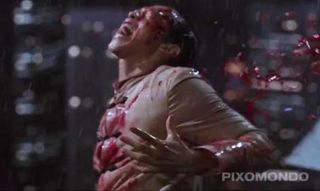
"I was 14 when I first got interested in 3D," he reveals. "I started making things at home - dinosaurs, things like that, using After Effects and Premiere." It quickly turned from hobby to profession. "I started working at a TV post-production company, on live comedy shows every week, doing some type animations," he explains.
"I did that up until I finished school," he explains. "After that I started making some small movies, using every bit of software around - 2D, 3D. Then I finally got a job working as a compositor and from then on things moved quite fast."
Ewers joined Pixomondo in 2008 and his first job was on American-German martial arts movie Ninja Assassin. He worked as a comper but also worked on the side with matte paintings. And it turned out to be an area he found a real affinity for. "I was particularly interested in matte paintings and environmental work," he explains. "I'd done a lot of drawing of environments as a kid. So once I realised you could do that digitally, I became really excited."
Supervisory roles
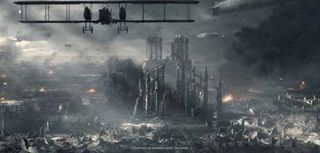
Soon he began to rise up the ranks. "The transition from matte artist to supervisor started when I went out to the US to work on 24," he recalls. "I began as a senior artist doing some painting and some compositing. And after one or two jobs like movies the supervisor said: 'Okay, let's give you two guys and you handle it yourself.'
Get the Creative Bloq Newsletter
Daily design news, reviews, how-tos and more, as picked by the editors.
From there, things snowballed. Ewers landed a series of roles as lead environment artist and later as environment supervisor, working on such films as 2012, Percy Jackson & the Olympians: The Lightning Thief, The Last Airbender, Suckerpunch, Fast Five, Super 8, Red Tails, Oblivion, After Earth and Hugo - which won a Best Visual Effects Oscar. And he thrived on the extra responsibility. "As an environment supervisor I was in a good position to improve how we do things, technology-wise and workflow-wise," he enthuses.
Then in 2012, he moved back to Germany. "I was supposed to do a supervising job in LA but that project didn't really work out, so that blew," he shrugs. But the project he came back for more than made up for it - Game of Thrones season 2.
Creative freedom
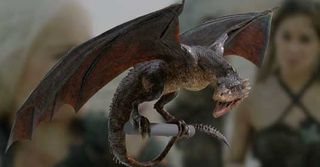
"I was to do environment supervision of the whole show, from concepts to execution," he explains. And it turned out to be the biggest job of his life. "It was incredible to work on a series where you have so many different types of environments," he says. "There were so many kinds of different tasks to do, of such a crazy variety. We had everything - dinosaurs and dragons, and 50-something locations. And everything was on such a huge scale."
Because of the numerous plot threads, there were a lot of relocations in the series, with scenes jumping quickly from the snowy north of Westeros to the desert city of Qarth to the Mediterranean-like King's Landing and back again. So the matte paintings had to instantly convey a vivid atmosphere and sense of place; the pressure was truly on.
But on the plus side, Pixomondo was given a substantial amount of creative freedom in envisioning these worlds, Ewers adds. "Places like Harrenhal [the largest castle in the seven kingdoms of the series] are described to a certain extent in the books. And HBO did some production concepts too. But there was still some room for interpretation; there was still some freedom to do things. So we were able to really unleash our imaginations on bringing these amazing worlds to life."
Real-world inspiration
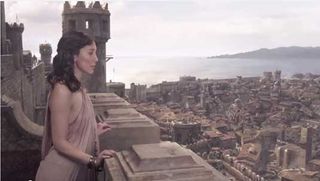
Pixomondo prepared by spending six months taking hundreds of photos in locations around the world as inspiration. The matte paintings for King's Landing, for example, were inspired by the city of Valletta in Malta, as well as the steep slopes of Scotland, in the green hills of Ireland and in the castles of Wales.
Once the research was complete, the process of building the CG environments for the show began. It was a long, collaborative process of constant refinement and improvement, with some 67 environments and 518 shots being edited over almost six months.
As an experience, you'd think it would be difficult to top that. But the next big project for Ewers - as division visual effects supervisor on Tom Cruise's hit action thriller Oblivion - was even more exciting. Because on this movie they essentially turned the conventional paradigm ('film the actors, then apply VFX in post') on its head.
Reinventing Front Projection
To make the sets feel real for the actors, Pixomondo decided to reinvent an old school technique, Front Projection, for 21st century moviemaking. They built a projection system six times larger than an IMAX screen, powered by 21 Full HD projectors, which could be moved to different parts of the set.
Not only did this mean the stars could add more naturally than against blue screen. The projector screens also provided almost all the lighting necessary for filming, and could even adapt to the time of day.
Under the supervision of Bjorn Mayer, Pixomondo filmed 32 hours of 5K footage for the projections at the top of a volcano in Hawaii, above the clouds, covering a 180-degree field of view. They then sped up the footage, to show the clouds 'boiling', as well as painting out unwanted artefacts like mountains and aircraft.
Start to finish
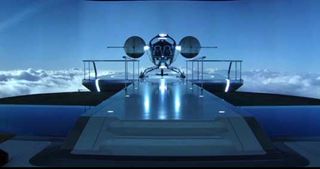
"The great thing about Oblivion was that we were involved from the beginning," Ewers enthuses. "We did 150 full CG shots, very complicated shots over eight months. But what made things easier was that we started so early.
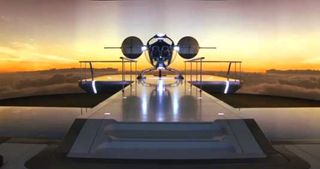
"So we were in there at preproduction working here in Stuttgart on all these projection things, the back projecting of clouds. Then Bjorn went to Hawaii and filmed them. And then back here we stitched them together and added text elements. And finally the projection guys took those clips and projected it onto the screen."
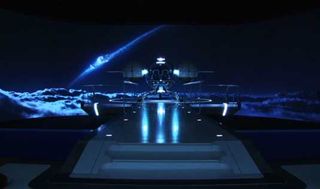
Something else in Oblivion thar Ewers is particularly proud of is the ice canyon chase sequence.
"We did that completely here in Stuttgart and it took around a year to create," he recalls. "In fact, with preproduction even longer than that, more than one and a half years. On average there were around 50 of us working on it at any one time."
Director Joseph Kosinski's idea was that it would be through a glacier that had been carved by lava flow. Having gone to Iceland to shoot reference footage, the final CG set produced by Pixomondo was 20km long, and made up of around a hundred 'block' variations.
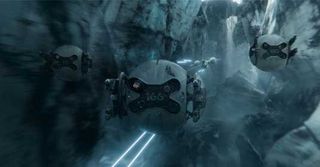
"Technically it was a very, very hard thing to do in the beginning," says Ewers. "Not even because of the cost or the number of people involved, but it's more like: 'How can we do that?'
"It looks very easy on paper, but as soon as you dip into the topic you find out it's not that easy." As ever, though, making the effort to go that extra mile was worth it, he concludes. "At the end of the day, people liked what we created, and that was very rewarding."
Win a trip to Los Angeles!
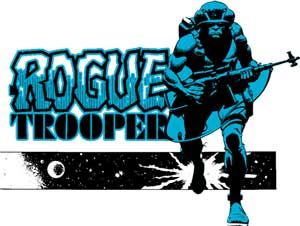
Masters of CG is a competition for EU residents that offers the one-in-a-lifetime chance to work with one of 2000AD's most iconic characters: Rogue Trooper.
We invite you to form a team (of up to four participants) and tackle as many of our four categories as you wish - Title Sequence, Main Shots, Film Poster or Idents. For full details of how to enter and to get your Competition Information Pack, head to the Masters of CG website now.
Enter the competition today!

Thank you for reading 5 articles this month* Join now for unlimited access
Enjoy your first month for just £1 / $1 / €1
*Read 5 free articles per month without a subscription

Join now for unlimited access
Try first month for just £1 / $1 / €1
Tom May is an award-winning journalist and editor specialising in design, photography and technology. Author of the Amazon #1 bestseller Great TED Talks: Creativity, published by Pavilion Books, Tom was previously editor of Professional Photography magazine, associate editor at Creative Bloq, and deputy editor at net magazine. Today, he is a regular contributor to Creative Bloq and its sister sites Digital Camera World, T3.com and Tech Radar. He also writes for Creative Boom and works on content marketing projects.
